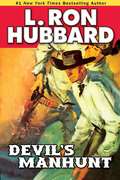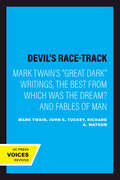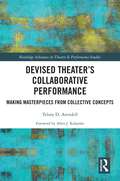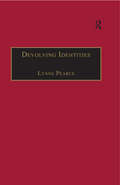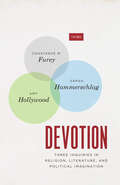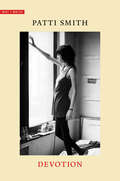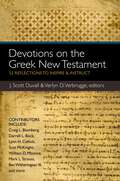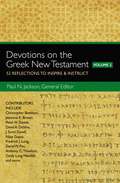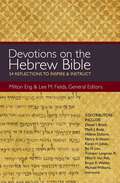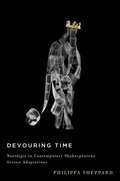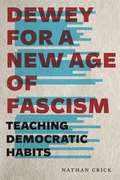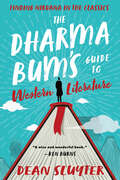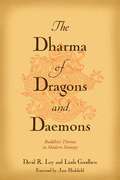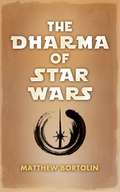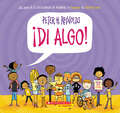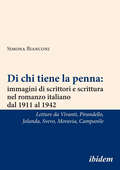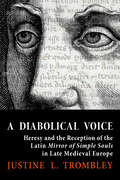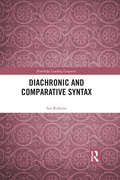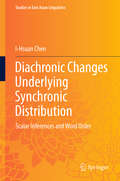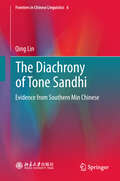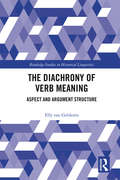- Table View
- List View
Devil's Manhunt
by L. Ron HubbardSaddle up with this riveting tale. Young Tim Beckdolt had been working Desperation Peak in Arizona for eight long, treacherous months before striking a rich seam of gold. Now, after three months of hard, grueling labor, he's stockpiled more than $175,000 of gold ore, and his dreams of wealth are about to be realized . . . that is until the loutish Swedish giant Sven and the foppish Virginian killer Bonnet, arrive to jump his claim. Forced by gunpoint to mine the remainder of the gold for this villainous pair, Tim manages to escape into the surrounding wilderness, only to be hunted like an animal through vicious terrain with no weapons to defend himself or food to sustain him. ALSO INCLUDES THE WESTERN STORIES "JOHNNY, THE TOWN TAMER" AND "STRANGER IN TOWN" "With the flair of a Louis L'Amour or Zane Grey." --True West*An International Book Awards Winner
The Devil's Race-Track: Mark Twain's "Great Dark" Writings, The Best from Which Was the Dream? and Fables of Man
by Mark TwainMark Twain explores the darker side of life in these lesser-known later writings dealing with personal tragedies, nightmarish world events, and a doubtful cosmic order. He views his own situation as that of a ship trapped in a fearsome Bermuda Triangle-like region, the Devil's Race-Track. He sees history as a treadmill of endlessly and monotonously repeated events. And he conceives of a universal food chain, a vast round of devourers who in their turn become victims, humankind and God included. The tone of these writings is lightened considerably by Mark Twain's sagely ironic humor and his warmth, which together balance his tough-mindedness. And even when he shows the human race caught in some vicious circle, he may be seen courageously seeking a way out and at times believing he has found it.
Devised Theater’s Collaborative Performance: Making Masterpieces from Collective Concepts (Routledge Advances in Theatre & Performance Studies)
by Telory D ArendellThis book provides a fascinating and concise history of devised theatre practice. As both a founding member of Philadelphia’s Pig Iron Theater Company and a Professor, Telory Arendell begins this journey with a brief history of Joan Littlewood’s Theatre Workshop and Living Newspapers through Brecht’s Berliner Ensemble and Joe Chaikin’s Open Theatre to the racially inflected commentary of Luis Valdez’s Teatro Campesino and Ariane Mnouchkine’s collaboration with Théâtre de Soleil. This book explores the impact of devised theatre on social practice and analyzes Goat Island’s use of Pina Bausch’s gestural movement, Augusto Boal’s Theatre of the Oppressed in Giving Voice, Anna Deavere Smith’s devised envelope for Verbatim Theatre, The Tectonic Theatre Project’s moment work, Teya Sepinuck’s Theatre of Witness, Pig Iron’s use of Lecoq mime to build complex physical theatre scripts, and The Riot Group’s musical arrangement of collaborative devised text. Included are a foreword by Allen J. Kuharski and three devised plays by Theatre of Witness, Pig Iron, and The Riot Group. Replete with interviews from the initial Pig Iron collaborators on subjects of writing, directing, choreographing, teaching, and developing a pedagogical platform that supports devised theatre.
Devolving Identities: Feminist Readings in Home and Belonging (Studies in European Cultural Transition #8)
by Lynne Pearce Martin Stannard Greg WalkerThere is no doubt that the political and cultural map of Europe is in the process of being radically redrawn. Alongside the major upheavals in continental Europe, the British Isles has undergone far-reaching constitutional reform. In Devolving Identities, feminist scholars explore their personal negotiations of gender, class, ethnicity and national or regional identity through their readings of two literary and cultural 'texts'. The collection centres on the ontological experience of reading and writing 'as a feminist', and combines the discussion of texts which are inscribed - whether consciously or unconsciously - with the academics' own struggle to reconcile their 'roots' with their current 'situations' or 'identities'. This book's focus on the overlapping of gender and national or regional identity is a direct response to the devolution movements currently active in the British Isles. The contributors are drawn from Scotland, Wales, Cornwall, Ireland, Northern Ireland and selected regions of England. In its complex engagement of subject and text and its political insistence that we no longer consider key aspects of 'identity' in isolation, this volume presents a truly state-of-the-art investigation of (a) what it means to be 'regionally defined' and (b) how the complexity of our positioning in terms of class, gender and nation impacts upon our practice as literary and cultural critics.
Devotion: Three Inquiries in Religion, Literature, and Political Imagination (TRIOS)
by Constance M. Furey Sarah Hammerschlag Amy HollywoodThree scholars of religion explore literature and the literary as sites of critical transformation. We are living in a time of radical uncertainty, faced with serious political, ecological, economic, epidemiological, and social problems. Scholars of religion Constance M. Furey, Sarah Hammerschlag, and Amy Hollywood come together in this volume with a shared conviction that what and how we read opens new ways of imagining our political futures and our lives. Each essay in this book suggests different ways to characterize the object of devotion and the stance of the devout subject before it. Furey writes about devotion in terms of vivification, energy, and artifice; Hammerschlag in terms of commentary, mimicry, and fetishism; and Hollywood in terms of anarchy, antinomianism, and atopia. They are interested in literature not as providing models for ethical, political, or religious life, but as creating the site in which the possible—and the impossible—transport the reader, enabling new forms of thought, habits of mind, and ways of life. Ranging from German theologian Martin Luther to French-Jewish philosopher Sarah Kofman to American poet Susan Howe, this volume is not just a reflection on forms of devotion and their critical and creative import but also a powerful enactment of devotion itself.
Devotion: Three Inquiries in Religion, Literature, and Political Imagination (TRIOS)
by Constance M. Furey Sarah Hammerschlag Amy HollywoodThree scholars of religion explore literature and the literary as sites of critical transformation. We are living in a time of radical uncertainty, faced with serious political, ecological, economic, epidemiological, and social problems. Scholars of religion Constance M. Furey, Sarah Hammerschlag, and Amy Hollywood come together in this volume with a shared conviction that what and how we read opens new ways of imagining our political futures and our lives. Each essay in this book suggests different ways to characterize the object of devotion and the stance of the devout subject before it. Furey writes about devotion in terms of vivification, energy, and artifice; Hammerschlag in terms of commentary, mimicry, and fetishism; and Hollywood in terms of anarchy, antinomianism, and atopia. They are interested in literature not as providing models for ethical, political, or religious life, but as creating the site in which the possible—and the impossible—transport the reader, enabling new forms of thought, habits of mind, and ways of life. Ranging from German theologian Martin Luther to French-Jewish philosopher Sarah Kofman to American poet Susan Howe, this volume is not just a reflection on forms of devotion and their critical and creative import but also a powerful enactment of devotion itself.
Devotion: Three Inquiries in Religion, Literature, and Political Imagination (TRIOS)
by Constance M. Furey Sarah Hammerschlag Amy HollywoodThree scholars of religion explore literature and the literary as sites of critical transformation. We are living in a time of radical uncertainty, faced with serious political, ecological, economic, epidemiological, and social problems. Scholars of religion Constance M. Furey, Sarah Hammerschlag, and Amy Hollywood come together in this volume with a shared conviction that what and how we read opens new ways of imagining our political futures and our lives. Each essay in this book suggests different ways to characterize the object of devotion and the stance of the devout subject before it. Furey writes about devotion in terms of vivification, energy, and artifice; Hammerschlag in terms of commentary, mimicry, and fetishism; and Hollywood in terms of anarchy, antinomianism, and atopia. They are interested in literature not as providing models for ethical, political, or religious life, but as creating the site in which the possible—and the impossible—transport the reader, enabling new forms of thought, habits of mind, and ways of life. Ranging from German theologian Martin Luther to French-Jewish philosopher Sarah Kofman to American poet Susan Howe, this volume is not just a reflection on forms of devotion and their critical and creative import but also a powerful enactment of devotion itself.
Devotion
by Patti SmithFrom the renowned artist and author Patti Smith, an inspired exploration of the nature of creative invention A work of creative brilliance may seem like magic—its source a mystery, its impact unexpectedly stirring. How does an artist accomplish such an achievement, connecting deeply with an audience never met? In this groundbreaking book, one of our culture’s beloved artists offers a detailed account of her own creative process, inspirations, and unexpected connections. Patti Smith first presents an original and beautifully crafted tale of obsession—a young skater who lives for her art, a possessive collector who ruthlessly seeks his prize, a relationship forged of need both craven and exalted. She then takes us on a second journey, exploring the sources of her story. We travel through the South of France to Camus’s house, and visit the garden of the great publisher Gallimard where the ghosts of Mishima, Nabokov, and Genet mingle. Smith tracks down Simone Weil’s grave in a lonely cemetery, hours from London, and winds through the nameless Paris streets of Patrick Modiano’s novels. Whether writing in a café or a train, Smith generously opens her notebooks and lets us glimpse the alchemy of her art and craft in this arresting and original book on writing. The Why I Write series is based on the Windham-Campbell Lectures, delivered annually to commemorate the awarding of the Donald Windham-Sandy M. Campbell Literature Prizes at Yale University.
Devotions on the Greek New Testament: 52 Reflections to Inspire and Instruct
by J. Scott Duvall Verlyn VerbruggeZondervan is known for its excellent resources in biblical languages, and many of our resources encourage professors, students, and pastors to continue to use their Hebrew and Greek Bibles beyond their seminary years.Devotions on the Greek New Testamentcontinues on this path of excellence by introducing these devotions—based on a careful reading and study of the Greek New Testament—written by some of the top Greek scholars of today. Contributors include Scot McKnight, Daniel B. Wallace, Craig L. Blomberg, Mark Strauss, and William D. Mounce, among others.Devotions on the Greek New Testament can be used as weekly devotional or as a supplemental resource throughout a semester or sequence of courses. The main point each devotion offers comes from a careful reading of the passage in the Greek New Testament, not from the English Bible. These authors use a variety of exegetical approaches in their devotions: grammatical, lexical, rhetorical, sociohistorical, linguistic, etc. Each devotion closes with a practical application.
Devotions on the Greek New Testament, Volume Two: 52 Reflections to Inspire and Instruct
by Paul Norman JacksonDevotions on the Greek New Testament, Volume Two contains an entirely new set of 52 devotions written by over 25 of today's best biblical language scholars. Contributors include Christopher Beetham, Jeannine K. Brown, Peter H. Davids, David A. DeSilva, J. Scott Duvall, Nijay Gupta, Frederick J. Long, David W. Pao, Anthony C. Thiselton, Cindy Long Westfall, and many more.The main point of each devotion in Devotions on the Greek New Testament, Volume Two comes from a careful reading of the passage in the Greek New Testament, not from an English translation. The authors use a variety of exegetical approaches in their devotions - including grammatical, lexical, rhetorical, sociohistorical, and linguistic - and each devotion closes with a practical application or spiritual reflection.Devotions on the Greek New Testament, Volume Two contains a devotion on every book in the New Testament and can be used as a weekly devotional or as a supplemental resource throughout a semester or sequence of courses. These devotions will inspire you to keep reading and meditating on the Scriptures and find new treasures from the biblical text.X
Devotions on the Hebrew Bible: 54 Reflections to Inspire and Instruct
by ZondervanThe main point of each devotion in Devotions on the Hebrew Bible comes from a careful reading of the passage in the Hebrew Bible, not from an English translation—written by some of the top biblical language scholars of today. Contributors include Daniel I. Block, Mark J. Boda, Hélène Dallaire, Nancy Erickson, Karen H. Jobes, Bo H. Lim, Tremper Longman III, Miles V. Van Pelt, Bruce K. Waltke, and Michael Williams, among others. The authors use a variety of exegetical approaches in their devotions—including grammatical, lexical, rhetorical, sociohistorical, and linguistic—and each devotion closes with a practical application or spiritual reflection.Miles Van Pelt, for example, shows that a careful analysis of a grammatical particle in Judges 3:9 elucidates the agent of Israel’s deliverance. Indeed, it is Yahweh who saves! Tremper Longman III explains the role of poetical parallelism in Psalm 1 and highlights how clearly the psalmist invites the reader to introspection, compelling the reader to follow the path of righteousness. And Bo Lim reminds the reader of the biblical precedent for expressing lament. He highlights the poetic artistry of the book of Lamentations, noting its beautiful acrostic, and confirms that both grief and hope provide the rhythm of faith and worship.Devotions on the Hebrew Bible contains a devotion on every book in the Old Testament and can be used as a weekly devotional or as a supplemental resource throughout a semester or sequence of courses. These devotions will inspire you to keep reading and meditating on the Hebrew Scriptures and find new treasures from the biblical text.
Devouring Time: Nostalgia in Contemporary Shakespearean Screen Adaptations
by Philippa SheppardFrom Kenneth Branagh’s groundbreaking Henry V to Justin Kurzel’s haunting Macbeth, many modern filmmakers have adapted Shakespeare for the big screen. Their translations of Renaissance plays to modern cinema both highlight and comment on contemporary culture and attitudes to art, identity, and the past. A dynamic analysis of twenty-seven films adapted from Shakespeare’s works, Philippa Sheppard’s Devouring Time addresses a wide range of topics, including gender, ritual, music, setting, rhetoric, and editing. She argues that the directors’ choice to adapt these four-hundred-year-old plays is an act of nostalgia, not only for the plays themselves, but also for the period in which they were written, the association of genius that accompanies them, and the medium of theatre. Sheppard contends that millennial anxiety brought on by the social and technological revolutions of the last five decades has generated a yearning for Shakespeare because he is an icon of a literary culture that is often deemed threatened. Authoritative and accessible, Devouring Time’s investigations of filmmakers’ nostalgia for the art of the past shed light on Western concepts of gender, identity, and colonialism.
Dewey for a New Age of Fascism: Teaching Democratic Habits (Rhetoric and Democratic Deliberation #22)
by Nathan CrickDuring the rise of fascism in the early twentieth century, American philosopher and educational reformer John Dewey argued that the greatest threat to democracy was not a political regime or even an aggressive foreign power but rather a set of dispositions or attitudes. Though not fascist in and of themselves, these habits of thought—rugged individualism and ideological nationalism—lay the foundation for fascism. In this study, Nathan Crick uses Dewey’s social thought and philosophy of education to provide insight into and resources for transforming our present-day politics.Through a close reading of Dewey’s political writings and educational theory, Crick elaborates Dewey’s vision of democratic social life and the education required for its foundation. He shows that for Dewey, communication is essential to cultivating sympathy, intelligence, and creativity—habits of thought that form the core of democratic culture. Crick then lays out a broad curriculum of logic, aesthetics, and rhetoric for inculcating these habits in the classroom, arguing that if we are to meet the challenge of fascism, we must teach these new arts as if our civilization depends on it—because in our new age of politics, it does.Comprehensive and pragmatic, this book presents an experimental model of education that can be applied across the humanities curriculum. It will be of interest to teachers of writing, composition, and rhetoric as well as scholars and students of communication studies, pedagogy, and political theory.
Dewey for a New Age of Fascism: Teaching Democratic Habits (Rhetoric and Democratic Deliberation)
by Nathan CrickDuring the rise of fascism in the early twentieth century, American philosopher and educational reformer John Dewey argued that the greatest threat to democracy was not a political regime or even an aggressive foreign power but rather a set of dispositions or attitudes. Though not fascist in and of themselves, these habits of thought—rugged individualism and ideological nationalism—lay the foundation for fascism. In this study, Nathan Crick uses Dewey’s social thought and philosophy of education to provide insight into and resources for transforming our present-day politics.Through a close reading of Dewey’s political writings and educational theory, Crick elaborates Dewey’s vision of democratic social life and the education required for its foundation. He shows that for Dewey, communication is essential to cultivating sympathy, intelligence, and creativity—habits of thought that form the core of democratic culture. Crick then lays out a broad curriculum of logic, aesthetics, and rhetoric for inculcating these habits in the classroom, arguing that if we are to meet the challenge of fascism, we must teach these new arts as if our civilization depends on it—because in our new age of politics, it does.Comprehensive and pragmatic, this book presents an experimental model of education that can be applied across the humanities curriculum. It will be of interest to teachers of writing, composition, and rhetoric as well as scholars and students of communication studies, pedagogy, and political theory.
The Dharma Bum’s Guide to Western Literature: Finding Nirvana in the Classics
by Dean SluyterHOW THE LITERATURE WE LOVE CONVEYS THE AWAKENING WE SEEK Suppose we could read Hemingway as haiku . . . learn mindfulness from Virginia Woolf and liberation from Frederick Douglass . . . see Dickinson and Whitman as buddhas of poetry, and Huck Finn and Gatsby as seekers of the infinite . . . discover enlightenment teachings in Macbeth, The Catcher in the Rye, Moby-Dick, and The Bluest Eye. Some of us were lucky enough to have one passionate, funny, inspiring English teacher who helped us fall in love with books. Add a lifetime of teaching Dharma — authentic, traditional approaches to meditation and awakening — and you get award-winning author Dean Sluyter. With droll humor and irreverent wisdom, he unpacks the Dharma of more than twenty major writers, from William Blake to Dr. Seuss, inspiring readers to deepen their own spiritual life and see literature in a fresh, new way: as a path of awakening.
The Dharma of Dragons and Daemons: Buddhist Themes in Modern Fantasy
by David R. Loy Linda Goodhew Jane HirshfieldIn order to live, we need air, water, food, shelter...and stories. This book is about Buddhist stories: not about stories to be found in Buddhism, but about the "Buddhism" to be found in some of the classics of contemporary fantasy including the works of J. R. R. Tolkien, Hayao Miyazaki, Michael Ende, Philip Pullman, and Ursula K. LeGuin.Many books are called groundbreaking, but this one is truly unique and sure to appeal to anyone with an interest in fantasy literature. It employs a Buddhist perspective to appreciate some of the major works of modern fantasy--and uses modern fantasy fiction to elucidate Buddhist teachings. In the tradition of David Loy's cutting-edge presentation of a Buddhist social theory in The Great Awakening, this pioneering work of Buddhist literary analysis, renown scholar David Loy and Linda Goodhew offer ways of reading modern fantasy-genre fiction that illuminate both the stories themselves, and the universal qualities of Buddhist teachings. Authors examined include J.R.R. Tolkien, Philip Pullman (of The Amber Spyglass trilogy, from whose works the word "daemon" is borrowed in the title), Ursula K. LeGuin, and the anime movie Princess Mononoke.
The Dharma of Star Wars
by Matthew BortolinPlumbing the Star Wars universe for spiritual lessons is as old as the first Star Wars film released in 1977. The author of this book looks through a specifically Buddhist lens, using Buddhist philosophy to interpret the characters, plots, and dialogue.
¡Di algo! (Say Something!)
by Peter H. ReynoldsFrom the creator of the New York Times bestseller The Word Collector comes an empowering story about finding your voice, and using it to make the world a better place.En este nuevo libro de cuentos, el querido autor Peter H. Reynolds explora muchas maneras en las que una sola voz puede hacer la diferencia. Cada uno de nosotros, cada día, tiene la oportunidad de decir algo: con nuestras acciones, nuestras palabras y nuestras voces. Este libro es perfecto para niños activistas de cualquier parte. Esta historia intemporal recuerda a los lectores la innegable importancia y el poder de sus voces. In this empowering new picture book, beloved author Peter H. Reynolds explores the many ways that a single voice can make a difference. Each of us, each and every day, have the chance to say something: with our actions, our words, and our voices. Perfect for kid activists everywhere, this timely story reminds readers of the undeniable importance and power of their voice. There are so many ways to tell the world who you are... what you are thinking... and what you believe. And how you'll make it better. The time is now: SAY SOMETHING!
Di chi tiene la penna: immagini di scrittori e scrittura nel romanzo italiano dal 1911 al 1942 [Italian-language Edition]
by Simona BianconiSimona Bianconi explores the creative process of writing, its communicative aspects and the traces of the writer himself in his creations, as well as the effect writing has on the personality of the author.Through the analysis of texts by six outstanding protagonists of the Italian novel in the first half of the 20th century, Bianconi gives answers to fascinating questions that arise about its creators and encourages the reader to experience and understand writing as a revelation of creativity and life.L'invenzione letteraria può dare vita a un secondo scrittore, a sua volta all'opera. A sua volta colui che comunica al di là della parola, che si assume l'importante responsabilità della creazione, che intende lasciare traccia di sé. Da lui nasce il libro, sua sfida, sostegno, tormento; prova unica o reiterata. Come prende forma nel romanzo di primo grado la figura centrale dell'autore? Come si mostra l'immagine ammaliante del suo lavoro nelle storie di lotta e rinuncia, successo e mediocrità presentate? E qual è l'effetto della scrittura sul personaggio - anche nella sua interazione sociale - che, pure tra gravi ostacoli, la elegge tra le vie da percorrere e ne fa il proprio destino?Attraverso la lettura di testi di sei straordinari protagonisti del romanzo italiano nella prima metà del Novecento, ideatori di altrettanti artisti, donne e uomini, si è tentato di dare una risposta ad interrogativi seducenti che il lettore si pone.. In tal modo, penetrando il motivo dell'esperienza della letteratura, si giunge a toccare la scrittura come rivelazione e sigillo di vita.
Di chi tiene la penna: Letture da Annie Vivanti, Luigi Pirandello, Jolanda, Italo Svevo, Alberto Moravia, Achille Campanile
by Simona BianconiSimona Bianconi explores the creative process of writing, its communicative aspects and the traces of the writer himself in his creations, as well as the effect writing has on the personality of the author.Through the analysis of texts by six outstanding protagonists of the Italian novel in the first half of the 20th century, Bianconi gives answers to fascinating questions that arise about its creators and encourages the reader to experience and understand writing as a revelation of creativity and life.L'invenzione letteraria può dare vita a un secondo scrittore, a sua volta all'opera. A sua volta colui che comunica al di là della parola, che si assume l'importante responsabilità della creazione, che intende lasciare traccia di sé. Da lui nasce il libro, sua sfida, sostegno, tormento; prova unica o reiterata. Come prende forma nel romanzo di primo grado la figura centrale dell'autore? Come si mostra l'immagine ammaliante del suo lavoro nelle storie di lotta e rinuncia, successo e mediocrità presentate? E qual è l'effetto della scrittura sul personaggio - anche nella sua interazione sociale - che, pure tra gravi ostacoli, la elegge tra le vie da percorrere e ne fa il proprio destino?Attraverso la lettura di testi di sei straordinari protagonisti del romanzo italiano nella prima metà del Novecento, ideatori di altrettanti artisti, donne e uomini, si è tentato di dare una risposta ad interrogativi seducenti che il lettore si pone.. In tal modo, penetrando il motivo dell'esperienza della letteratura, si giunge a toccare la scrittura come rivelazione e sigillo di vita.
A Diabolical Voice: Heresy and the Reception of the Latin "Mirror of Simple Souls" in Late Medieval Europe (Medieval Societies, Religions, and Cultures)
by Justine L. TrombleyIn A Diabolical Voice, Justine L. Trombley traces the afterlife of the Mirror of Simple Souls, which circulated anonymously for two centuries in four languages, though not without controversy or condemnation. Widely recognized as one of the most unusual and important mystical treatises of the late Middle Ages, the Mirror was condemned in Paris in 1310 as a heretical work, and its author, Marguerite Porete, was burned at the stake. Trombley identifies alongside the work's increasing positive reception a parallel trend of opposition and condemnation centered specifically around its Latin translation. She's discovered fourteenth- and fifteenth-century theologians, canon lawyers, inquisitors, and other churchmen who were entirely ignorant of the Mirror's author and its condemnation and saw in the work dangerous heresies that demanded refutation and condemnation of their own. Using new evidence from the Mirror's largely overlooked Latin manuscript tradition, A Diabolical Voice charts the range of negative reactions to the Mirror, from confiscations and physical destruction to academic refutations and vicious denunciations of its supposedly fiendish doctrines. This parallel story of opposition shows how heresy remained an integral part of the Mirror's history well beyond the events of 1310, revealing how seriously churchmen took Marguerite Porete's ideas on their own terms, in contexts entirely removed from Marguerite's identity and her fate. Emphasizing the complexity of the Mirror of Simple Souls and its reception, Trombley makes clear that this influential book continues to yield new perspectives and understandings.
Diachronic and Comparative Syntax: A Comparative History Of English And French (Routledge Leading Linguists #28)
by Ian RobertsThis book brings together for the first time a series of previously published papers featuring Ian Roberts’ pioneering work on diachronic and comparative syntax over the last thirty years in one comprehensive volume. Divided into two parts, the volume engages in recent key topics in empirical studies of syntactic theory, with the eight papers on diachronic syntax addressing major changes in the history of English as well as broader aspects of syntactic change, including the introduction to the formal approach to grammaticalisation, and the eight papers on comparative syntax exploring head-movement, the nature and distribution of clitics, and the nature of parametric variation and change. This comprehensive collection of the author’s body of research on diachronic and comparative syntax is an essential resource for scholars and researchers in theoretical, comparative, and historical linguistics.
Diachronic Changes Underlying Synchronic Distribution: Scalar Inferences And Word Order (Studies In East Asian Linguistics Ser.)
by I-Hsuan ChenThis book deals with synchronic variation in Chinese through a diachronic lens, based on the evidence from a quantitative, longitudinal corpus study. Departing from the traditional analysis in diachronic changes in Chinese linguistics, the cognitive constructionist approach employed in this book is able to capture incremental changes by combining syntax, semantics, and pragmatics. Topics such as word order, focus, scopes of quantifiers, information structure, and negation have been important issues in linguistics, but they are rarely integrated as a whole. The book makes their diachronic interactions available to the students and researchers in the fields of general and Chinese linguistics.
The Diachrony of Tone Sandhi: Evidence from Southern Min Chinese (Frontiers in Chinese Linguistics #6)
by Qing LinThis book investigates the diachronic change of the tone sandhi of Southern Min Chinese, which is known for its synchronic arbitrariness and opacity. It argues that in final-prominent tone sandhi, the change of final tones and the change of non-final tones can be highly independent and essentially different from each other. Accordingly, it proposes a new position-based diachronic approach to study the separate evolution of tones occurring at different positions. This book is the first study to rigorously and systematically explore the diachrony of Southern Min tone sandhi.
The Diachrony of Verb Meaning: Aspect and Argument Structure (Routledge Studies in Historical Linguistics)
by Elly van GelderenThis innovative volume offers a comprehensive account of the study of language change in verb meaning in the history of the English language. Integrating both the author’s previous body of work and new research, the book explores the complex dynamic between linguistic structures, morphosyntactic and semantics, and the conceptual domain of meaning, employing a consistent theoretical treatment for analyzing different classes of predicates. Building on this analysis, each chapter connects the implications of these findings from diachronic change with data from language acquisition, offering a unique perspective on the faculty of language and the cognitive system. In bringing together a unique combination of theoretical approaches to provide an in-depth analysis of the history of diachronic change in verb meaning, this book is a key resource to researchers in historical linguistics, theoretical linguistics, psycholinguistics, language acquisition, and the history of English.
